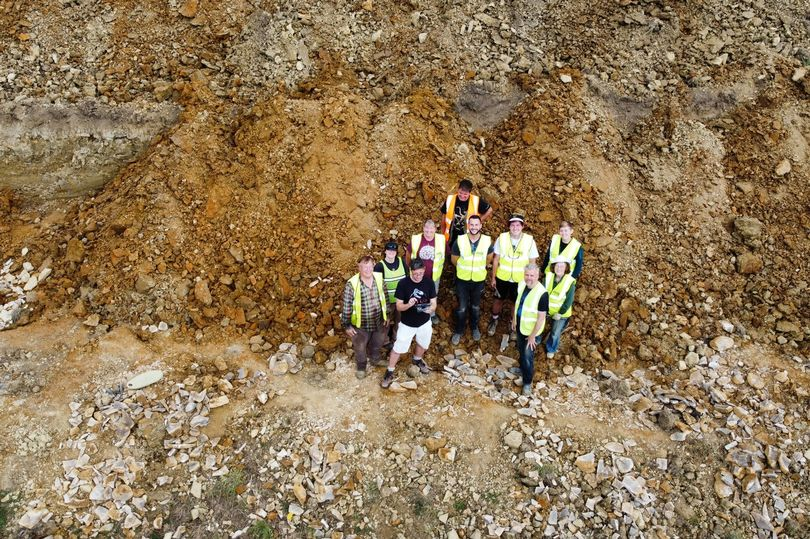Jurassic fossils fond at ‘Remarkable’ farm site dating back to dinosaur era


Jurassic fossil found at a farm off the M5 in the Midlands near Stroud (Image: Dean Lomax)
Fossils dating back a staggering 183 million years have been unearthed from a Midland farmer’s field off the M5. The archaeological treasures have been dug up from Court Farm at Cotswolds village Kings Stanley and date back to an era when dinosaurs roamed the region.

The dig site off the M5 where Jurassic fossils were found (Image: Steve Dey)
A team of palaeontologists discovered preserved fish, marine reptiles, squids and rare insects in what they believe was once a Jurassic sea that spanned near to Worcestershire. Layers of limestone have kept the fossils intact at the field belonging to Adam Knight.
Despite being hidden for thousands of years, photos of the fish fossils show that even their eyeballs, scales and fins can still be seen clearly. Among the finds was the head of a Pachycormus Jurassic fish.
Dr Dean Lomax, a palaeontologist and visiting scientist at The University of Manchester, said: “The site is quite remarkable, with numerous beautifully preserved fossils of ancient animals that once lived in a Jurassic sea that covered this part of the UK.

Beautifully preserved fish head from the period when dinosaurs roamed the region
(Image: Dean Lomax)
“Inland locations with fossils like this are rare in the UK. The fossils we have collected will surely form the basis of research projects for years to come.”
Fossil collectors Sally and Neville Hollingworth were behind the discovery. It’s not the first time they have struck gold as they also uncovered remains of mammoths at Cotswold Water Park.

One of the Jurassic fossils found in the farmer’s field
(Image: Dean Lomax)
Mr and Mrs Hollingworth, who were on BBC One documentary Attenborough and the Mammoth Graveyard last year, said: “These fossils come from the Early Jurassic, specifically a time called the Toarcian.
“The clay layers exposed at this site near Stroud have yielded a significant number of well-preserved marine vertebrate fossils.
“The fossils are comparable to the famous and exquisitely preserved similar fauna of the Strawberry Bank Lagerstätte from Ilminster, Somerset – a prehistoric site of exceptional fossil preservation.
“Excavations at Kings Stanley have revealed a rich source of fossil material, particularly from a rare layer of rock that has not been exposed since the late 19th Century.”
A team of eight scientists were involved in the latest dig this Summer. During that time, roughly 200kg of clay was collected and sieved in a state-of-the-art sediment processing machine to extract small teeth and bones.
Many specimens collected will be donated to Stroud’s Museum in the Park to add to its palaeontology collection.
Nigel Larkin, specialist palaeontological conservator, said: “Give a person a fish and you feed them for a day. Give a palaeontologist a fossil fish and they will tell you the species, the age of the rock, the climate of the time when the fish was alive, plus the water depth and salinity and plenty of other information.
“This site – already an interesting farm in a beautiful setting – is one big outdoor classroom.”
Related Post
A shocking documentary proves that mermaids do exist
SHOCKING Revelation: Thuya, Mother of Queen Tiye, Was the Grandmother of Akhenaten and Tutankhamun—What Ancient Egyptian Secrets Did She Leave Behind?
Breaking News: Astonishing Discoveries at Karahan Tepe Confirm an Extraterrestrial Civilization is Hiding on Earth, and NO ONE Knows!
Breaking News: Researchers FINALLY Discover U.S. Navy Flight 19 After 75 Years Lost in the Bermuda Triangle!
NASA’s Secret Investigation: Uncovering the Astonishing Mystery of the UFO Crash on the Mountain!
Explosive UFO Docs LEAKED: Startling Proof That Aliens Ruled Ancient Egypt!